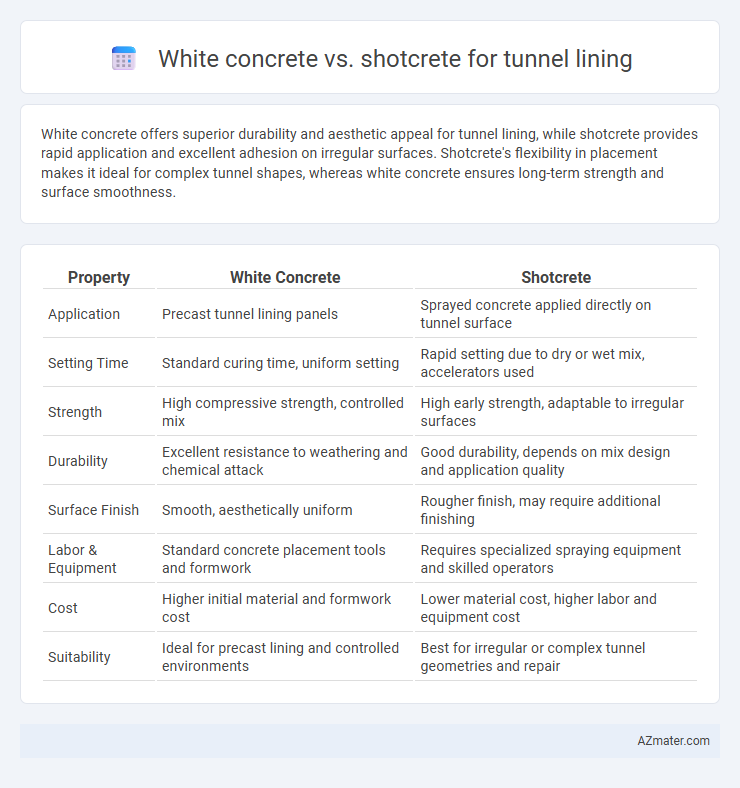White concrete offers superior durability and aesthetic appeal for tunnel lining, while shotcrete provides rapid application and excellent adhesion on irregular surfaces. Shotcrete's flexibility in placement makes it ideal for complex tunnel shapes, whereas white concrete ensures long-term strength and surface smoothness.
Table of Comparison
| Property | White Concrete | Shotcrete |
|---|---|---|
| Application | Precast tunnel lining panels | Sprayed concrete applied directly on tunnel surface |
| Setting Time | Standard curing time, uniform setting | Rapid setting due to dry or wet mix, accelerators used |
| Strength | High compressive strength, controlled mix | High early strength, adaptable to irregular surfaces |
| Durability | Excellent resistance to weathering and chemical attack | Good durability, depends on mix design and application quality |
| Surface Finish | Smooth, aesthetically uniform | Rougher finish, may require additional finishing |
| Labor & Equipment | Standard concrete placement tools and formwork | Requires specialized spraying equipment and skilled operators |
| Cost | Higher initial material and formwork cost | Lower material cost, higher labor and equipment cost |
| Suitability | Ideal for precast lining and controlled environments | Best for irregular or complex tunnel geometries and repair |
Introduction to Tunnel Lining Materials
White concrete and shotcrete are essential materials used in tunnel lining, each offering distinct advantages based on application requirements. White concrete provides high durability, aesthetic appeal, and precise mold shaping, making it suitable for visible tunnel sections or architectural finishes. Shotcrete, sprayed pneumatically onto surfaces, ensures rapid application, adaptability to complex geometries, and excellent adhesion, proving ideal for temporary support and initial lining stabilization in tunneling projects.
Overview of White Concrete in Tunnel Lining
White concrete in tunnel lining offers enhanced aesthetic appeal and improved visibility due to its high reflectance, which aids in safer and more efficient operations within tunnels. Its composition typically includes white Portland cement and light-colored aggregates, providing superior brightness compared to traditional grey concrete. The material also exhibits strong durability and resistance to chemical attacks, making it suitable for the demanding underground environment.
Understanding Shotcrete for Tunnel Construction
Shotcrete, a pneumatically applied concrete mixture, is essential for tunnel lining due to its rapid application and excellent adhesion to irregular surfaces, offering immediate structural support. Its flexibility in mixing and placement enables reinforced or plain concrete layers tailored to varied geotechnical conditions within tunneling projects. In contrast, white concrete, often used for aesthetic finishes, lacks the adaptability and fast-setting properties critical in dynamic underground construction environments.
Material Properties Comparison: White Concrete vs Shotcrete
White concrete typically offers higher compressive strength and improved durability due to its controlled mix design, making it ideal for structural tunnel lining requiring smooth finishes and aesthetic appeal. Shotcrete, applied pneumatically, excels in adhesion and early strength gain, allowing rapid support of complex tunnel surfaces while accommodating irregular geometries and minimizing formwork. Both materials provide distinct advantages; white concrete ensures homogeneity and surface quality, while shotcrete offers flexibility and efficient placement in challenging tunnel environments.
Application Methods: Casting vs Spraying
White concrete is typically applied through casting, allowing precise shaping and smooth finishes ideal for visible tunnel linings, while shotcrete involves spraying a concrete mixture at high velocity onto tunnel surfaces for rapid application in complex geometries. Casting white concrete requires formwork and is suited to controlled environments, whereas shotcrete's method is advantageous for irregular surfaces and fast setting in tunnel reinforcement. The choice between casting and spraying directly impacts structural integrity, surface quality, and installation speed in tunnel lining projects.
Durability and Longevity in Tunnel Environments
White concrete offers superior aesthetic appeal with moderate durability for tunnel linings, relying on its low permeability and high-quality aggregates to resist chemical attack and abrasion. Shotcrete provides enhanced durability and longevity in tunnel environments due to its dense application, strong adhesion to rock surfaces, and resistance to water infiltration, making it ideal for irregular substrates and rapid setting under varied conditions. Tunnel projects prioritize shotcrete for structural support and long-term durability, while white concrete is chosen when surface finish and visual inspection ease are critical.
Aesthetic and Lighting Considerations
White concrete for tunnel lining enhances aesthetic appeal by providing a smooth, bright surface that reflects light effectively, improving visibility and reducing the need for artificial lighting. Shotcrete, while versatile and quick to apply, typically results in a rougher texture and darker finish, which can absorb light and diminish overall brightness within the tunnel. Choosing white concrete over shotcrete for tunnel linings supports improved lighting efficiency and creates a cleaner, more visually appealing environment.
Installation Speed and Project Timeframes
Shotcrete accelerates tunnel lining installation by allowing rapid application directly onto surfaces without formwork, significantly reducing project timeframes. White concrete requires traditional casting and curing processes, extending installation duration compared to shotcrete. For projects prioritizing speed and efficiency in tunnel lining, shotcrete offers faster turnaround and minimizes delays in construction schedules.
Cost Analysis: White Concrete vs Shotcrete
White concrete generally incurs higher material and finishing costs compared to shotcrete due to its specialized composition and aesthetic requirements in tunnel linings. Shotcrete offers cost efficiency through faster application rates and reduced labor expenses, particularly in complex tunnel geometries, minimizing formwork and scaffolding needs. Lifecycle cost analysis reveals shotcrete's potential for lower overall expenses, especially in projects emphasizing speed and flexibility, while white concrete may justify investment where durability and surface quality are paramount.
Best Practices for Selecting Tunnel Lining Solutions
White concrete offers enhanced visibility and aesthetic appeal for tunnel lining, making it suitable for projects requiring precise inspection and illumination. Shotcrete provides superior adaptability and faster application, ideal for complex geometries and reinforcement in tunnel construction. Best practices for selecting tunnel lining solutions involve assessing site conditions, structural requirements, and durability needs to balance performance with cost-effectiveness.

Infographic: White concrete vs Shotcrete for Tunnel lining
 azmater.com
azmater.com